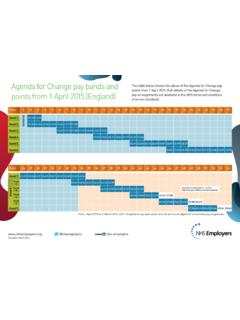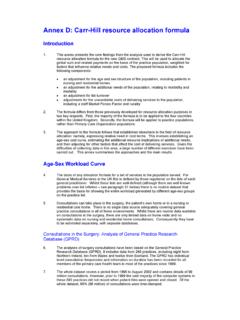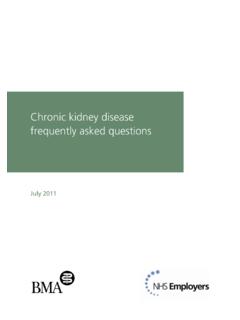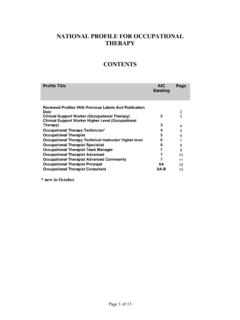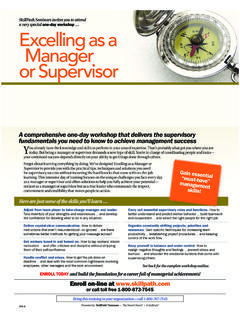Transcription of NHS Job evaluation handbook
1 NHS Job evaluation handbook Fourth edition, July 2013. NHS Job evaluation handbook Contents The contents of this handbook have been agreed in partnership by the NHS Staff Council 1. Introduction to Job evaluation 3. 2. The status of additional guidance 9. 3. Mainstreaming Job evaluation 11. 4. Merger and reconfigurations of health service organisations 15. 5. Factor plan and guidance notes 19. 6. Job evaluation weighting and scoring 71. 7. Job evaluation weighting scheme scoring chart 73. 8. Job evaluation band ranges 74. 9. Guide tothe use of profiles 75. 10. Job descriptions and Agenda for Change 79. 11. Matching procedure 81. 12. Hybrid Matching/ evaluation Procedure 90. 13. National protocol for local evaluations 92. 14. Consistency checking 98. 15. Blocked local matching/ evaluation /consistency checking 103. protocol 16. Glossary 105. 2. 1. Introduction to Job evaluation 1. Overview of contents This version of the Job evaluation (JE) handbook incorporates NHS Staff Council advice which has been published since the second edition of the handbook , as well as the factor plan and procedures to implement job evaluation (JE) in your organisation.
2 In this first introductory section, the text is either in bold or non-bold: bold is used for the tools for carrying out the matching/ evaluation processes non-bold is used for associated advice from NHS Staff Council to cover a number of possible scenarios. Chapter 1 provides the background to the JE scheme. Chapter 2 contains advice on the status of guidance approved by the NHS Staff Council, professional bodies and staff side organisations and whether advice is mandatory or advisory. Chapters 3 and 4 contain essential guidance for future use of the scheme in a changing NHS, either when roles are new or change, or when the service is reconfigured. Chapter 5 contains the factor plan and important guidance notes on how to apply it. Chapters 6, 7 and 8 have information on the weighting and scoring of the scheme and the band ranges. Chapter 9 explains the development and use of national job profiles and chapter 10 gives the NHS Staff Council advice on job descriptions and Agenda for Change (AfC).
3 Chapters 11, 12 and 13 describe in detail the job matching, hybrid matching/ evaluation and job evaluation protocols, and chapter 14. reinforces the importance of the consistency checking process. Finally, chapter 15 sets out the NHS Staff Council procedure on what to do if one of the evaluation processes become blocked at a local level. 2. The background on NHS pay structures before Agenda for Change Collective bargaining arrangements and associated pay structures have changed relatively little since the creation of the National Health Service (NHS) in 1948 until the introduction of AfC in 2004. NHS Job evaluation handbook 3. Pre October 2004, in line with industrial relations practice in the public sector in the immediate post-war period, there was an over-arching joint negotiating body for the sector, the General Whitley Council, and more than 20 individual joint committees and subcommittees for the different occupational groups, each with responsibility for its own grading and pay structures, and terms and conditions of employment.
4 There had been some developments, mainly from the early 1980s onwards, in response to increasing tensions within the system, for example: Reviews of individual grading structures. The most well known of these (largely because of the high number of appeals generated) was the introduction of the Clinical Grading Structure for nurses and midwives on 1 April 1988, which brought in the previous grades A to I. There were other grading structure reviews in the late 1980s and early 1990s which covered professions including estates officers, speech and language therapists and hospital pharmacists. There was no attempt to undertake cross-Whitley Committee reviews. The introduction of independent pay review bodies for doctors and dentists (1971), and nursing staff, midwives, health visitors and professions allied to medicine (1984). These took evidence from all relevant parties and recommended annual pay increases. They replaced the traditional collective bargaining approach, which was considered to have delivered unsatisfactory pay levels for some key public sector groups, but had no remit to compare pay from one group to another (even among their remit groups).
5 Staff groups not covered by pay review bodies continued to use collective bargaining on pay increases but these increasingly mirrored the pay review body settlements. Changes to health service legislation from 1992. These changes allowed organisations to develop their own terms and conditions and to apply these to new and promoted employees, although existing employees could choose to retain their Whitley terms and conditions. Most trust terms and conditions shadowed the relevant Whitley arrangements in most areas, but a small number of trusts introduced totally new pay and grading structures, and other terms and conditions. These were generally based on the various commercial job evaluation systems available at the time eg Medequate, Hay. By the mid-1990s this resulted in a mixture of pay and grading systems, with some significant defects: Difficulty in accommodating developing jobs, such as healthcare assistants, operating department practitioners (ODPs), and multi-disciplinary team members, who might be carrying out similar roles, but whose salaries could vary significantly, depending on the occupational background of the jobholders.
6 NHS Job evaluation handbook 4. Inability to respond quickly to technological developments and changes to work organisation, even where everyone agreed they were desirable. Inability to respond to external labour market pressures, causing severe recruitment and retention problems in some areas. Additional increments, which could be applied flexibly to meet such pressures, were introduced into a number of the major Whitley structures, but these were insufficient to solve the problems. From a union perspective, the Whitley system was viewed as having delivered low pay compared with other parts of the public sector and unequal pay between the various Whitley groups. 3. The equality background Health service pay structures and relativities were well established long before the advent of UK anti-discrimination legislation. Professional and managerial groups benefited from negotiations, following a 1948 Royal Commission on Equal Pay to achieve equal pay between men and women carrying out the same work.
7 However female ancillary staff were paid lower rates than their male colleagues until the Equal Pay Act in 1970, which made such practices illegal. Under the Equal Pay Act, the gap between male and female ancillary pay rates was eliminated in stages between 1970 and 1975. However, as the Equal Pay Act only applied where women and men were undertaking: like work', that is, the same or very similar work (who were already generally receiving equal pay). work rated as equivalent under a job evaluation scheme' (only ancillary workers in the health service were covered by job evaluation ) it had little impact elsewhere in the health service. From 1984, the Equal Pay Act was amended to allow equal pay claims where the applicant considered that they were carrying out: work of equal value' (when compared under headings such as effort, skill and decision') to a higher paid male colleague. The equal value amendment has resulted in many claims to employment tribunals, mainly by women who believe that they are paid less than men doing work with similar demands.
8 In an important case for the NHS, speech and language therapists submitted equal value claims comparing their work to that of clinical psychologists and clinical pharmacists. The European Court of Justice found in favour of the claimants [Enderby v Frenchay Health Authority and Secretary of State for Health (1993)]. This, together with the need to simplify the existing pay systems, influenced the decision to introduce a new job evaluation scheme in the NHS. NHS Job evaluation handbook 5. 4. The first Job evaluation Working Party The first Job evaluation Working Party (known retrospectively as JEWP I) was set up in the mid1990s to review those job evaluation schemes introduced in the NHS following the 1992 health reform legislation. Its stated aim was to develop a kitemarking' system for those meeting equality requirements. JEWP I developed a set of criteria for what would make a fair and non-discriminatory scheme for use in the NHS and tested a number of schemes against these criteria.
9 None met all the criteria but some were better than others. The Working Party also evaluated an agreed list of jobs against each of six off the shelf JE. schemes to ascertain whether or not they would deliver similar outcomes. There were some significant differences in the resulting rank orders. JEWP I, therefore, concluded that it was not possible to kitemark' schemes for NHS use and it would be necessary to develop a tailor-made scheme. 5. The Agenda for Change proposals In 1999, the Government published a paper Agenda for Change: Modernising the NHS. pay system. The proposals set out in that paper included: A single job evaluation scheme to cover all jobs in the health service to support a review of pay and all other terms and conditions for NHS employees. Three pay spines for: (1) doctors and dentists; (2) other professional groups covered by the Pay Review Body; (3) remaining non-Pay Review Body staff. A wider remit for the Pay Review Body covering the second of these pay spines.
10 6. The development of the NHS Job evaluation Scheme Following the publication of Agenda for Change: Modernising the NHS pay system, the Job evaluation Working Party was re-constituted (JEWP II and subsequently referred to as JEWP) as one of a number of technical sub-groups of the Joint Secretariat Group (JSG), a sub-committee of the Central Negotiation Group of employer, union and Department of Health representatives, set up to negotiate new health service grading and pay structures. The stages in developing the NHS Job evaluation Scheme were: a. Identifying draft factors. This drew on the work of JEWP I in comparing the schemes in use in the NHS. NHS Job evaluation handbook 6. b. Testing draft factors. This was done using a sample of around 100 jobs. Volunteer jobholders were asked to complete an open-ended questionnaire, providing information under each of the draft factor headings and any other information about their jobs which they felt was not covered by the draft factors.
